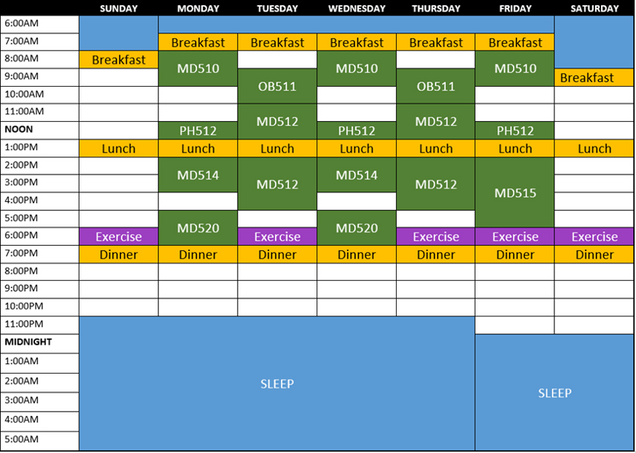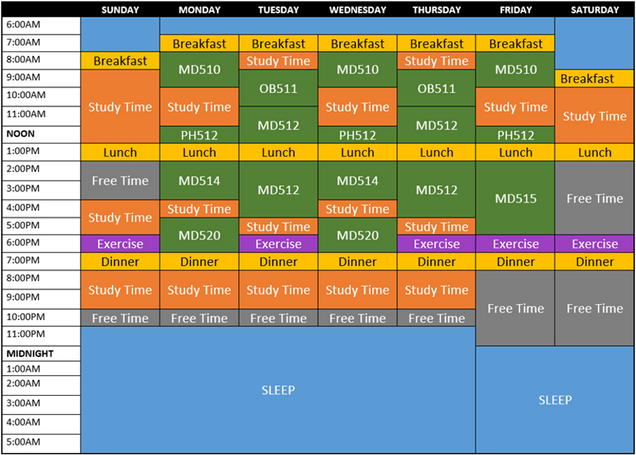Tips for Managing Your Time during LfA
For many students, the Learn from Anywhere (LfA) model has created greater flexibility in their schedules. Unfortunately, as you make your way through the semester, deadlines may start to multiply, and school-life balance may seem elusive. This is where adding greater structure to your schedule and trying out some new techniques can help you stay on track academically while maintaining a healthy, balanced lifestyle.
Look Ahead, Plan Backwards
Throughout the semester, you will likely be navigating multiple competing deadlines for your courses. It’s important to map out those key dates ahead of time so that you can distribute the workload and avoid pulling all-nighters to finish projects at the last minute.
The calendar below is an excerpt from a Semester at a Glance calendar. At the beginning of each semester, it’s helpful to map out all of your exam dates, project and paper deadlines, and any personal or family commitments that might make certain weeks feel busier than others. Filling out a Semester at a Glance calendar this week, with all of your remaining deadlines, will help you develop a realistic plan for completing your projects and exam preparations on time. You can download a sample calendar here.

For each deadline on your Semester at a Glance, you can implement Reverse Planning. Break each assignment down into smaller tasks, and plan backwards, from the due date to the present, estimating how much time each task will take as you go. Not only does Reverse Planning reduce the time pressure of preparing for exams and presentations, it also improves focus, motivation, and performance as you work toward milestones in your degree program and professional development.
Beef up Your Weekly Calendar
Another strategy that can help you stay on track during these final weeks of the semester is revisiting your weekly calendar. At the beginning of the semester, most graduate students enter their class schedule, work hours (if they have a job), and recurring appointments into their weekly calendars. As the semester progresses though, many students struggle to balance the commitments that aren’t included on their weekly calendars: sleep, meals, exercise, study time, and free time. These are things we all recognize are essential but we assume will magically fit into the white space on our calendars. The trouble is, as the semester ramps up and deadlines begin to loom, our best intentions for maintaining a healthy, balanced lifestyle often falter. In the moment, we often make poor time management decisions. For example, when you sit down to study, too much white space on your calendar can lull you into procrastinating. What we need is a system that allows us to quickly visualize exactly how much time we have available to work on the tasks we need to complete.

One solution is to take a more comprehensive approach to your weekly calendar, transforming it into a 24 Hour Time Grid that reflects both your external commitments and your commitments to yourself. You can create your 24 Hour Time Grid using any weekly calendaring platform that works for you, e.g. Google Calendar, iCal, or a paper planner.
As you enter your class schedule, you’ll want to use color coding to indicate which classes are meeting in person and which are meeting remotely. If you are enrolled in a course with asynchronous components such as pre-recorded lectures, you’ll also want to schedule a consistent time each week to access these course materials and take notes on them.
Commit to Balance
After you’ve entered your schedule of classes, work, and recurring appointments, the next step is to schedule time for your commitments to yourself. Start by blocking off 7-8 hours of sleep a night. There are two excellent reasons to schedule your sleep! First, the goal of a 24 Hour Time Grid is to help you achieve an accurate understanding of how many hours you have available for study time. If you leave sleep time open, it is tempting to glance at your calendar during the day and reassure yourself that you have plenty of time to finish your work. Later in the day, it’s tempting to cut into valuable sleep time by staying up later. A second reason to schedule your sleep is that sleep deprivation negatively impacts cognitive function. When you’re sleep deprived, it becomes harder to concentrate on your work and harder to remember material that you’re learning. Conversely, studies show that good sleep leads to better problem-solving and creativity. Most importantly, sleep allows your brain to organize and consolidate the information it has learned during the day. So, sleep isn’t optional! It’s essential, and thus, it deserves to be represented in your weekly calendar.
After sleep, be sure to block off time for three meals a day and exercise at least three times per week. Wellbeing is extremely important, yet is often one of the first things we sacrifice when we start to feel “too busy” during the semester. Good nutrition fuels not just your body, but also your brain. And researchers have found that exercise doesn’t just benefit your physical health! It also boosts your creativity and restores your ability to focus.

Schedule Your Study Hours
At this stage, the remaining “white space”on your calendar reflects the true amount of time you have available each week for either study time or free time. It’s important to strike a balance between study and free time so that your mind has opportunities to decompress.
As you schedule your study time, keep in mind that, for every credit hour you are registered for, it is best to block out two hours of study time each week. For a 16 credit course load, this means reserving 30-32 hours of study time per week. There may be weeks where your assignment load is lighter, so you can use the excess for leisure time. But, particularly during the busy final weeks of the semester, you will thank yourself for guarding those 32 hours each week!

Make the Most of Your Study Time
As you study, it’s best to work in short, intense bursts using the Pomodoro Technique. To implement the technique, first, set a specific goal you can achieve in 25 minutes. This may mean breaking a larger assignment into smaller tasks, which you will complete over several Pomodoro sessions. Next, before you begin working, eliminate all distractions and set a timer for 25 minutes. A helpful timer that helps you visualize your productivity and combat digital distraction is the Forest app. While your timer runs, focus exclusively on your chosen task. Once the timer goes off, take a five minute break to reward yourself. Then set a new goal and repeat the Pomodoro cycle three more times before taking a longer, 15-30 minute break.
The breaks that are built into the Pomodoro Technique may seem like they are just for fun, but, much like sleep, they are actually essential to the learning process. Professor Barbara Oakley, author of A Mind for Numbers, argues that we have two different modes of thinking: focused mode and diffuse mode. Focused mode is what most of us picture when we think of studying. Focused mode means concentrating intently on material that we are trying to learn or memorize. Diffuse mode, on the other hand, is when we aren’t focused on anything in particular. In the diffuse mode, we start to see the big picture and make connections. The diffuse mode explains why some of our biggest “Aha!” moments come to us when we are cooking dinner or folding laundry.
Optimal learning occurs when we allow our minds to go back and forth between these two modes of thinking. This is why the Pomodoro Technique is such a powerful learning tool.
In closing…
In combination, the Semester at a Glance, Reverse Planning, the 24 Hour Time Grid, and the Pomodoro Technique can help you maintain focus, motivation, and a sense of balance during the busy final weeks of the semester. If you have any questions about integrating these new strategies into your routine, please reach out to BU’s Educational Resource Center. Our staff offer workshops on time management, study strategies, and more. We also offer one-on-one Academic Skills Advising appointments where you can meet with a professional staff member to develop a personalized plan for academic success.
Sarah Garibova, Ph.D.
Assistant Director for Outreach
Educational Resource Center
Boston University